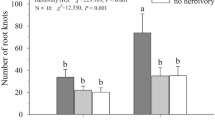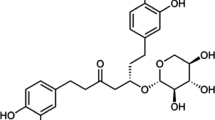Summary
Garrigue plant species growing on a calcareous substrate in southern France had higher foliar N levels than the same species growing on a relatively lower nutrient siliceous substrate (maquis). However maquis species had significantly higher foliar levels of P, more water, higher phenolic concentrations and larger leaf areas. The cumulative amount of insect damage on garrigue and maquis plants was similar, presumably due to different nutritional “advantages” in each case. Soil fertilization signifincantly elevated N levels in Q. coccifera, increased total leaf areas, decreased condensed tannin levels, and these leaves showed significantly more insect damage. Some effects of burning on Q. coccifera are also described. In these shrublands, fertilization may render leaf material more nutritional for herbivores by increasing nitrogen content and decreasing condensed tannin concentration, although very heavy grazing pressure may increase levels of leaf phenolics.
Similar content being viewed by others
References
Barry TN, Forss DA (1983) The condensed tannin content of vegetative Lotus pedunculatus, its regulation by fertilizer application, and effect upon protein solubility. J Sci Food Agric 34:1047–1056
Bottner P (1970) La matière organique des principaux types de sols sous l'ètage bioclimatique du Chêne vert dans le Midi de la France. Science du Sol 1:3–18
Chapin FS (1980) Nutrient allocation and responses to defoliation in tundra plants. Arc Alp Res 12:553–563
Coley P (1983) Herbivory and defensive characteristics of tree species in a lowland tropical forest. Ecol Monogr 53:209–233
Coley PD, Bryant JP, Chapin FS (1985) Resource availability and plant antiherbivore defense. Science 230:895–899
Daget P, Poissonet J (1972) From the structure of the vegetation to its quality and productivity in pastures. Fourrages 49:31–39
Davies RI, Coulson CB, Lewis DA (1964) Polyphenols in plants, humus and soil. IV. Factors leading to increase in biosynthesis of polyphenol in leaves and their relationship to mull and mor formation. J Soil Sci 15:310–318
Del Moral R (1972) On the variability of chlorogenic acid concentration. Oecologia 9:289–300
Dement WA, Mooney HA (1974) Seasonal variation in the production of tannins and cyanogenic glycosides in the chaparral shrub, Heteromeles arbutifolia. Oecologia 15:65–76
Di Castri F (1981) Mediterranean-type shrublands of the world. In: Di Castri F, Goodall DW, Specht RL (eds) Ecosystems of the world. Vol. 2. Mediterranean-type shrublands. Elsevier, Amsterdam pp 1–43
Di Castri F, Mooney HA eds (1973) Mediterranean-type ecosystems: origin and structure. Springer, Berlin Heidelberg New York
Dugrand R (1964) La garrigue Montpellieraine. Presses Universite de France, Paris
Gershenzon J (1984) Changes in the levels of plant secondary metabolites under water and nutrient stress. Recent Adv Phytochem 18:273–321
Givnish TJ (1987) Comparative studies of leaf form: assessing the relative roles of selective pressures and phylogenetic constraints. New Phytol 106:131–160
Glyphis JP (1985) Herbivory and tannin polyphenols in mediterranean ecosystems. Ph D thesis, University of Cape Town
Glyphis JP, Puttick GM (1988) Phenolics in some southern African mediterranean shrubland plants. Phytochem 27:743–751
McKey D, Waterman PG, Mbi CN, Gartlan JS, Srubsaker TT (1978) Phenolic content of vegetation in two African rain forests: ecological implications. Science 202:61–64
McNaughton SJ (1979) Grassland-herbivore dynamics. In: Sinclair ARE, Norton-Griffiths M (eds) Serengeti—dynamics of an ecosystem. University of Chicago Press, Chicago pp 46–81
Poissonet P, Poissonet J, Thiault M, Rambal S (1982) Range experimental dynamics, management and hydrology in “garrigue” of Quercus coccifera L. (S-France). In: Conrad CE, Oechel WC (eds) Proceedings of the symposium on dynamics and management of mediterranean-type ecosystems, June 1981, San Diego CA. Pacific Southwest, Forest and Range Expeirmental Station, Box 245, Berkeley CA 94701 p 627
Rapp M, Lossaint P (1981) Some aspects of mineral cycling in the garrigue of southern France. In: Di Castri F, Goodall DW, Specht RL (eds) Ecosystems of the world. Vol. 11. Mediterranean-type shrublands. Elsevier, Amsterdam pp 289–302
Rhoades DF (1979) Evolution of plant chemical defense against herbivores. In: Rosenthal GA, Janzen DH (eds) Herbivores: their interaction with secondary plant metabolites. Academic Press, New York pp 3–54
Rhoades DF (1983) herbivores population dynamics and plant chemistry. In: Denno RF, McClure MS (eds) Variable plants and herbivores in natural and managed systems. Academic Press, New York pp 155–220
Robbins CT (1983) Wildlife feeding and nutrition. Academic Press, New York pp 155–220
Stock WD, Lewis OAM (1986) Soil nitrogen and the role of fire as a mineralizing agent in a South African coastal fynbos ecosystem. J Ecol 74:317–328
Thiault M, Prud'hon M, Reboul M, Bechet A, Molenat G, Theriez A (1979) Amelioration pastorale de la garrigue. Journees du Grenier de Theix INRA 10:375–396
Trabaud L (1981) Man and fire: impacts on mediterranean vegetation. In: Di Castri F, Goodall DW, Specht RL (eds) Ecosystems of the world. Vol. 11. Mediterranean-type shrublands. Elsevier, Amsterdam pp 523–537
Trabaud L (1983) The effects of different fire regimes on soil nutrient levels in Quercus coccifera garrigue. In: Kruger FJ, Mitchell DT, Jarvis JUM (eds) Mediterranean-type ecosystems. The role of nutrients. Springer, Berlin Heidelberg New York pp 233–245
Trabaud L, Lepart J (1980) Diversity and stability in garrigue ecosystems after fire. Vegetatio 43:49–57
Van Emden HF (1966) Studies on the relations of insect and host plant. III. A comparison of the reproduction of Brevicoryne brassicae and Myzus persicae (Hemiptera: Aphididae) on brussels sprout plants supplied with different rates of nitrogen and potassium. Ent Exp Appl 9:444–460
Waterman PG, Choo GM, Vedder AL, Watts D (1983) Digestibility, digestion inhibitors and nutrients of herbaceous foliage and green stems from an African montane flora and comparison with other tropical flora. Oecologia 60:244–249
Westcott RJ, Henshaw GG (1976) Phenolic synthesis and phenylalanine ammonia lyase activity in suspension cultures of Acer pseudoplatanus L. Planta 131:67–73
Author information
Authors and Affiliations
Rights and permissions
About this article
Cite this article
Glyphis, J.P., Puttick, G.M. Phenolics, nutrition and insect herbivory in some garrigue and maquis plant species. Oecologia 78, 259–263 (1989). https://doi.org/10.1007/BF00377164
Received:
Issue Date:
DOI: https://doi.org/10.1007/BF00377164




